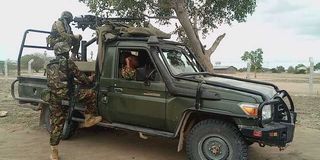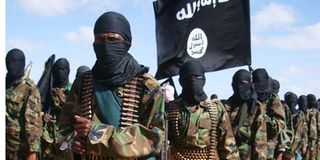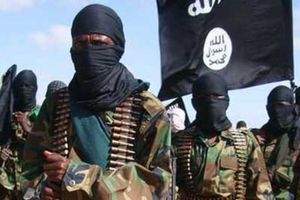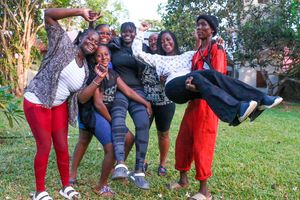
KDF soldiers on patrol in Garissa. Most common targets of Al-Shabaab are security agents, military patrols, government employees and communication masts.
Security agencies in northeastern Kenya are on high alert as Al-Shabaab fighters continue terrorising residents.
Mandera is the most affected county, with the latest attack reported on March 24 when Al-Shabaab militants raided Ires-Suki village and killed police reservist Abdiker Adan Ibrahim.
Security officers responding to the incident narrowly escaped death when their armoured vehicle hit an explosive planted on the road.
Mr Ahmed Abdow, a resident, lost his pick-up truck to armed men believed to be members of the terrorist group on March 6.
While driving in Mandera town, Mr Abdow was flagged down by the men but he defied them.
He was shot in the right leg and the vehicle driven to Somalia.
A police reservist was shot dead at a mosque in Harerihosley, Mandera East Sub-County, on February 25.
The armed men, dressed in civilian clothes, walked into the mosque compound and shot the reservist before walking away around 4 pm.
A group of Kenya Defence Forces soldiers from Elwak Camp was attacked at the notorious Corner S on the Wargadud-Rhamu road on February 24. The soldiers were looking for firewood when they came under fire.
One was killed, five others sustained serious injuries while 15 others had minor injuries.
Several people in a private vehicle on the Takaba-Wargadud-Rhamu road narrowly escaped death when a roadside explosive missed its target on the same day.
The group was returning from a rally organised by Senator Ali Roba’s United Democratic Movement party in Mandera West Sub-County.
Acting on intelligence, police officers arrested Mr Isaack Abdi Mohamed and Mr Noor Yakub Ali in Mandera East Sub-County on February 18.
Police later said the pair was planning to abduct Chinese nationals working on a sewerage project in Mandera town.
The two appeared in court in Nairobi on Monday.
Despite the almost daily occurrences, North Eastern Regional Commissioner John Otieno maintains that the security situation is stable.
“The situation is manageable, with isolated cases of Al-Shabaab attacks. There have been threats and attacks on security personnel and installations,” the administrator said.
He added that the latest incidents involved attacks on police reservists in Fafi, Garissa County, and Ires-Suki.
“Security agencies are dealing with these threats. We have put in place the necessary measures, including patrols and lock-ups,” the North Eastern Regional Security and Intelligence Committee Chairman told the Saturday Nation.
According to Mr Otieno, the region has more than enough security personnel, but proximity to the border with Somalia remains a challenge.
He added that it is common for northeastern Kenya to experience an increase in the number of attacks, especially during the Muslim holy month of Ramadhan.
“We have organised security agencies to counter the threats,” Mr Otieno said, without explaining why the group attacks more frequently during this period.
He said enhanced intelligence gathering has helped thwart terrorist attacks.
“Intelligence is helping us conduct targeted patrols and raids in areas we believe are vulnerable. However, it is unfortunate that we lost police reservists in the recent attacks,” the administrator said.
Mr Otieno added that reservists are soft targets as they are embedded in communities.
“Their response capacity makes them easy targets, but we have made arrangements to integrate them with our security forces,” he said.
Al-Shabaab fighters abducted five chiefs in Mandera South on October 3, a day before President William Ruto toured the county. The five are still being held in Somalia.
The abducted administrators are Adawa Abdi Mohamed, Mr Mohamed Hassan Kulumia, Mr Mohmednur Hache, Mr Abdi Hassan Suraw and Mr Ibrahim Gabow.
Also Read: Abducted Mandera chiefs: Local elders left to negotiate as families say victims were sickly
Interior Principal Secretary Raymond Omollo has ruled out the use of force to return the chiefs home.
He said the government is negotiating with officials in Somalia to have the chiefs freed.

Internal Security and National Administration Principal Secretary Raymond Omollo.
In Wajir County, Al-Shabaab activity has been recorded in Khorof Harar, Diff and Kotulo sub-counties.
The acts include forced zakat collection from herders near the border with Somalia.
Fighters have also been asking about government vehicles plying supply routes.
In Mandera, Al-Shabaab presence is noted in Mandera Central, Mandera North, Arabia, Lafey and Kutulo.
Here, the fighters demand information on local leadership, the strength and location of security camps, patrol patterns and the arms used by security personnel, including police reservists.
In Garissa, security installations like Ege, Fafi GSU Camp, Hagadera, Yumbis, Benane, Saretho and Nanighi are on high alert.
The other high-risk areas are Welmerer, Ijara, Hulugo, Alinjugur, Alango Arba and Kambioos.
Major Al-Shabaab routes in Garissa include Alango-Dadaab, Alinjugur-Kiwanja, Kulan-Abdisugow-Damajale and Hulugho-Mchanga Nyekundu-Sangailu.
Garissa recorded its worst incident this year when militants raided a police reservist camp, killing six and injuring four on March 23.
Government security agencies in Garissa say Amuma-Welmerer-Alinjugur-Alango and Bura East-Nanighi-Korakora-Ijara-Bodhei routes are frequently used by militants.

Al-Shabaab fighters.
Khorof Harar, Konton and Qarsa in Wajir have borne the brunt of Al-Shabaab activity. Common routes are Wajir-Tarbaj-Kutulo, Khorof Harar-Wajir and Qarsa-Kutulo. Al-Shabaab targets communication masts.
In Mandera, Al-Shabaab attacks quarry workers in Mandera South, West and North.
High-alert areas include Burmayo, El-Rhamu, Wargadud, Guba, Fino, Elele, Jabibar, Warankara and Alungo. Sheikh Barrow and Lafey are also affected.
Major supply routes used by Al-Shabaab fighters in Mandera include Kutulo-Elwak-Rhamu-Mandera, Elwak-Lafey-Fino-Arabia and Takaba-Banisa-Rhamu-Mandera.
Madera most hit
According to a report on violent extremist trends by the Centre for Human Rights and Policy Studies, Mandera recorded the most incidents in northeastern Kenya in 2024. The county reported 41 raids and 55 fatalities.
The report says the most common targets are security agents, military convoys and government employees.
Garissa recorded the second-highest number, with 33 attacks and 32 fatalities. Three attacks targeting security officers and civilians were reported in Wajir.
Mandera suffers the most due to its proximity to the border with Somalia. Mr Otieno says the attacks were reported on the border.
“These incidents occur in areas near the border. Infiltration by Al-Shabaab from Somalia is not difficult,” he said.
Wajir shares a small border segment with Somalia, leading to fewer attacks.
“Three sub-counties border Somalia in Wajir,” he said.
The Boni enclave is blamed for most incidents in Garissa.
“A large section of Garissa is in Boni forest, which borders Somalia,” Mr Otieno said.
Fafi, Hulugho and Bodhai are in the enclave and record Al-Shabaab infiltration.










